The Chuwi LapBook 12.3 Review: Premium Feel, Budget Price
by Brett Howse on September 6, 2017 8:00 AM EST- Posted in
- Laptops
- Apollo Lake
- Goldmont
- Chuwi
Display Analysis
When you consider that the Surface Pro has one of the best displays in a PC, it’s never going to be a bad thing for Chuwi to leverage Microsoft’s panel production in order to outfit their devices. This isn’t the only Chuwi device which has the same panel as a Surface either; the Chuwi Hi-13 2-in-1 tablet uses the 3000x2000 13.5-inch panel from the Surface Book. Maybe we’ll get lucky and they’ll release an AIO with the Surface Studio’s 28.125-inch 4500x3000 display too. They seem to have no qualms about using these panels, and the customer is the winner in the end.
It’s fair to say that none of us really wanted the laptop industry to move to 16:9 displays, but when HDTV standardized on that aspect ratio, the entire industry built their tooling around that, so anyone offering anything other than 16:9 would be doing so at a significant increase in cost. That ended the 16:10 aspect ratio for pretty much all devices, although a few tablets did end up using it, without much success.
When you consider that much of what we do on a laptop involves height, it really has been a shame to see the taller displays disappear, but with the success of the 3:2 aspect on some devices, it’s great to see a PC manufacturer like Chuwi step in and utilize that supply chain.
With 267 pixels per inch, this is certainly in the realm of High DPI for most people. Windows can still struggle with that, although for most tasks, it’s not the issue it once was. Some apps, like Steam, can still be a pain in High DPI, but if you’re looking at a LapBook 12.3, you can pretty much ignore Steam anyway. The high number of pixels per inch, coupled with the taller than normal display, really do make a difference.
Some may recall that the Surface Pro lineup, which shares this display panel, is also one of the most accurate displays around, but Microsoft calibrates each display at the factory. It’s pretty much an impossibility that Chuwi would be able to do the same, considering the different price categories these two devices are in, but to see how the LapBook 12.3 fares, we’ve tested it with SpectraCal’s CalMAN software suite, along with an X-Rite i1Pro2 colorimeter for brightness and contrast testing, and the X-Rite i1Pro2 Spectrophotometer for color accuracy testing.
Brightness and Contrast
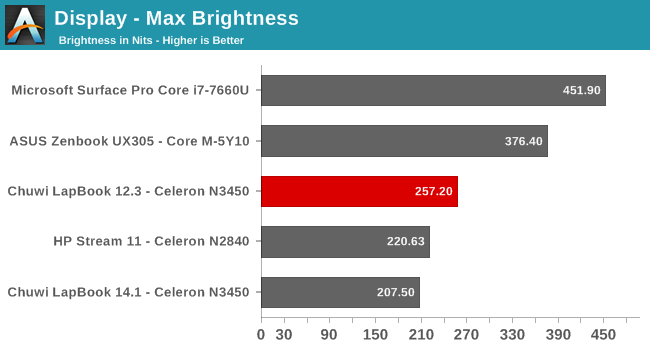
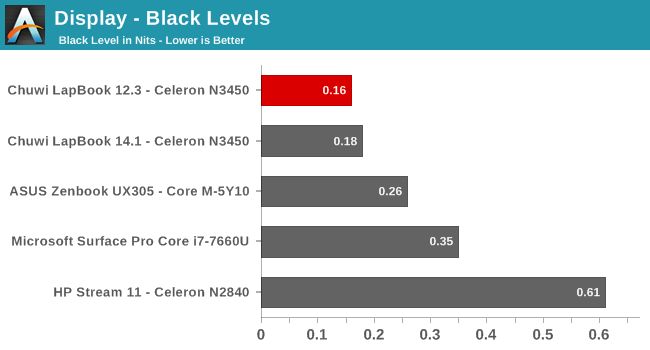
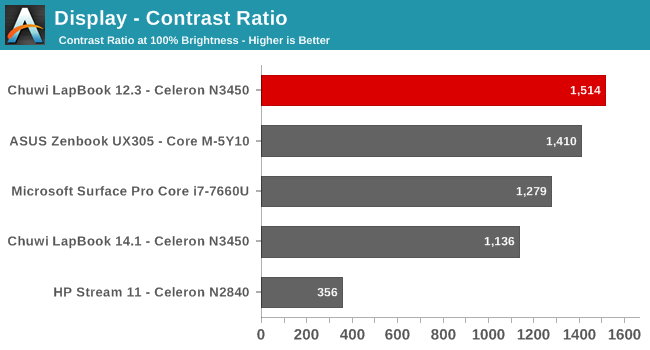
Although the backlight on the Chuwi LapBook 12.3 doesn’t get overly bright, it does have great contrast ratios, with a very dark black on this LCD display. It’s impressive that such an inexpensive laptop can have this kind of contrast. For those looking to use the LapBook in the dark, it’s not advisable since it doesn’t have a backlit keyboard, but also because the display only goes down to 37 nits at 0% brightness, which is still pretty bright for a very dark room.
Grayscale

Here’s the first indications that Chuwi hasn’t bothered with calibrating this panel at all. Grayscale on the LapBook 12.3 is quite awful. The grayscale results show the green values climbing as the brightness level increases, and at maximum brightness, the dE2000 is well over 10. It’s just not good, but it’s also expected at this price point.
Gamut

The panel and backlighting actually does a decent job covering the sRGB gamut, with 100% color levels that are quite close to the correct levels. The white point is what throws the average up so high, and here we can clearly see the white point drifting into green quite a bit.
Saturation

Much as we saw at the extreme 100% levels in the Gamut test, the saturation sweep shows a similar picture. The color levels are surprisingly solid on this device, and it’s mostly let down by the white point.
Gretag Macbeth
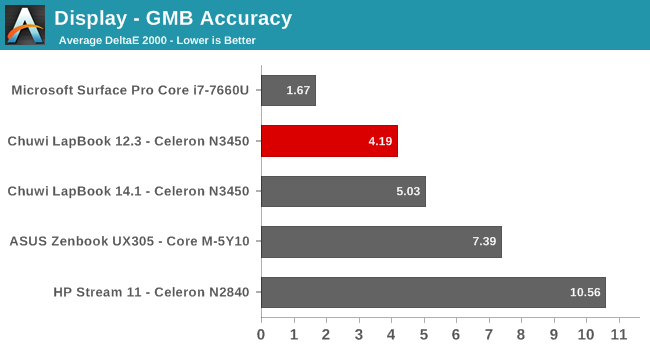
The most comprehensive test is the Gretag Macbeth, which doesn’t just test the primary and secondary colors, but also mixes in many other shades, as well as the important skin tones. The overall average is actually pretty decent again, although values under 3.0 would be better. Looking a the colors, most of them are decent but the whites and blacks show the most error.
Relative Colorchecker
Just to get a perspective on what these errors would look like, we’ve also run the colorchecker on the LapBook. Note that this is a relative error level, since any errors on your own display may affect the picture. Colors on the bottom are the target, and what’s displayed on the panel is on the top.
Here you can easily see the green cast on this display, but as we saw in the other tests, the color levels are much stronger.
Display Conclusion
It feels like its almost a shame that Chuwi wasn’t able to calibrate these devices at the factory, since the grayscale would be easily correctable and would make this display one of the best around, but thanks to it’s ultra-low price point, a calibrated display would be a bit of a stretch to expect. Still, the highlights of this display are the pixel density and aspect ratio, and for most people buying this laptop, the green cast isn’t going to be a huge issue, especially if they are coming from a TN display.


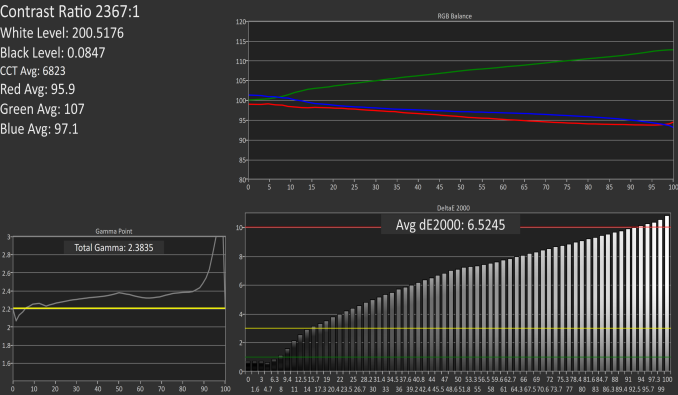












60 Comments
View All Comments
ianmills - Thursday, September 7, 2017 - link
I guess the bigger one has a copper heatsink. Techtablets has a bunch about this. Adding a copper heatsink can improve performance quite a bitvanilla_gorilla - Wednesday, September 6, 2017 - link
This doesn't seem that shocking of a price. For $270 you can get an all aluminum Acer Chromebook 14 with a 1080p IPS display, 4GB RAM and 32GB eMMC. And the acer has been available for several months.tipoo - Wednesday, September 6, 2017 - link
I have it. I hope they updated it to Apollo Lake soon, the Braswell CPU is pretty slow.kefkiroth - Wednesday, September 6, 2017 - link
I think it's at least a little surprising. The LapBook 12.3 has 2 more GB of RAM, a slightly better processor, a much higher resolution display, and double the storage for just ~$60 more.systemBuilder - Wednesday, September 6, 2017 - link
RAM is $10/GB = $20.Flash is $0.50/GB = $16
Better screen, I guess, is about $18 more, markup is assumed 10%.
tipoo - Wednesday, September 6, 2017 - link
I don't think Windows is free in this screen sizenotashill - Wednesday, September 6, 2017 - link
What BIOS version was used for testing? I've seen some people on the Chuwi forums say that the most recent BIOS update significantly raised maximum brightness, seems to be dated 2017/06/12.See: http://forum.chuwi.com/forum.php?mod=viewthread&am...
http://forum.chuwi.com/thread-4473-1-1.html
jabber - Wednesday, September 6, 2017 - link
If you can put Neverware on this and you have a great Chromebook!BrokenCrayons - Thursday, September 7, 2017 - link
I's prefer a Linux disto if looking into an alternative OS. Chromebooks are distressingly limited in capability. The end user is probably better off leaving Windows in place since it can do anything Chrome OS can do and a lot more.jabber - Sunday, September 10, 2017 - link
Well as this is essentially a Chromebook re-purposed for Windows I'd say ChromeOS would work better. I use a mix of Windows and ChromeOS machines and it is so nice to use a Machine that doesnt take ages to update and boot etc. ChromeOS just works and for a lot of people that's all they want. If not why did MS bother with the farce that is Windows S?